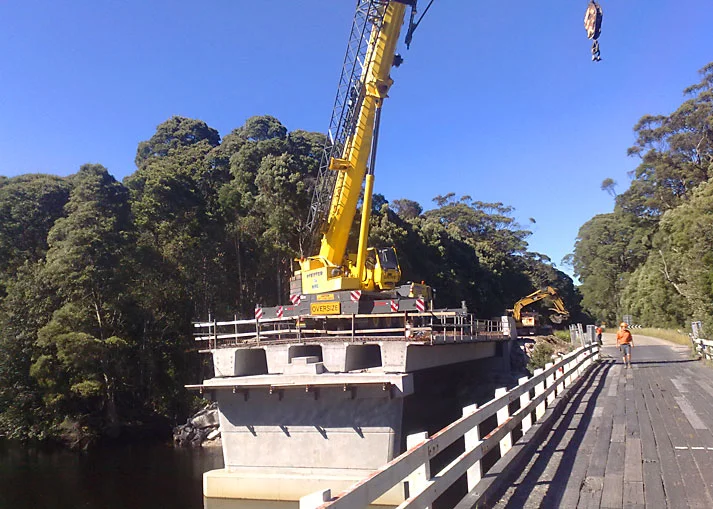Located in Ulverstone, the Leven River Bridge is situated where the river meets the ocean. The bridge was being erected on pylons, which were being placed by a Pylon Driver. Alongside the main bridge, a temporary wooden bridge had been erected, which the pylon driver was using as a base. The driver slipped and fell, wedging the machine between the temporary bridge and the driven pylons.
To get the Pylon Driver out of this situation we had to take the 80-tonne crane onto the wooden bridge, drive 8 temporary pylons onto each side of the bridge and put the outrigger down on these pylons. The Pylon machine weighed approximately 45 tonnes. We then welded lifting lugs onto the Pylon Driving machine and used 25-tonne chain blocks to help rig the load and get the required angle of the machine, ready for lifting. Then we went back to the job at hand erected a new Bridge!
Difficulties particular to Tasmania
- Power lines at bridge sites, 90% of the time the lines run right alongside the job.
- Narrow roads – On some of the country roads the larger cranes take up the entire road, on both sides. This is especially true of the 100-tonne crane which is over 3.1 metres in width.
- On jobs where the vegetation is thick, such as up in the highlands, we need to set the cranes up on short outriggers, which in turn decrease the cranes capacity.
- Planning the route to the jobs can be tricky. There are some roads the cranes are not allowed on due to the road size or due to the load limits. There is sometimes a situation where the bridges on the country roads are not designed to carry heavy loads, some will not take over 20 tonnes. The 100 tonne Grove weighs 60 tonnes and is a 5 axle machine, permits need to be granted for travel on certain roads in Tasmania.
The small size of the market in Tasmania may limit the use of Tower Cranes but for Pfeiffer Cranes they use All Terrain mobile cranes and there is no restriction on demand. There are many times when a larger Crane would be beneficial for our clients. A 200 tonne or a 220 tonne have been in demand at various times, such as;
- When constructing bridges, there are times when the uneven ground creates a situation for more reach.
- Derailments – a larger crane would reduce the need for multiple setups and for moving the crane as it would have more reach.
- Shutdown Maintenance – The restricted ground area, allows for short outriggers, decreasing the cranes capacity, a larger crane would allow more flexibility.
- Recovery works eg accidents when the crane needs to be set up at a distance due to hazards.
- Relocation of houses.
Weather is not a major problem and would be similar in problems to most Victorian Crane Companies, however, winter in Tasmanian would create the most nonproductive days due to wet weather and wind.

